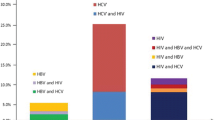Abstract
Between March 1986 and March 1994, the seroconversion to HBV associated to the seroconversion to HIV was investigated in 120 HIV seroconverters drawn from 2368 i.v. drug misusers screened for HIV, HBV and STDs. Among the 185 individuals susceptible to HIV and HBV at intake (41/120 HIV seroconverters and 144/364 HIV-negative controls), HBV seroconversion was associated with the seroconversion to HIV (p=0.006) and history of more than 3 sexual pratners per year (p=0.000). Only the history of more than 3 partners per year remained associated with the HBV seroconversion in the conditional regression. The associated seroconversion to HIV and HBV was linked to the short period of i.v. drug injections (p=0.032), history of more than 3 partners per year (p=0.000) and more than 3 i.v. drug injections per day (p=0.016). Compared to the seroconverters to HBV alone, the seroconverters to HBV and HIV were likely to have higher frequency of i.v. drug injection per day on univariate (p=0.031) and multivariate analysis (p=0.024). The seroconverters to both the viruses differed from the seroconverters to HIV alone in the year of drug debut (p=0.045), short period of i.v. drug use (p=0.048) and high frequence of injection per day (p=0.008). The multivariate analysis confirmed only the association with high frequency of injection per day (p=0.033). Higher risk of HIV seroconversion from the debut of i.v. drug use was observed in the subjects with concurrent HBV seroconversion (Log-Rank test:p=0.0008).
Similar content being viewed by others
Abbreviations
- ALT:
-
alanine aminotransferase
- CI:
-
95% confidence interval
- HBcAb:
-
antibody to hepatitis B core antigen
- HBsAg:
-
hepatitis B surface antigen
- HBV:
-
Hepatitis B virus
- HIV:
-
Human immunodeficiency virus
- HR:
-
hazard ratio
- OR:
-
Odds ratio
- SD:
-
standard deviation
- STDs:
-
sexually transmitted diseases
References
Alter HJ, Seef LB, Kaplan PM, et al. Type B hepatitis: the infectivity of blood positivity for e antigen and DNA polymerase after accidental needlestick exposure. N Engl J Med 1976; 295: 909–913
Berris B. Chronic viral disease. Can Med Assoc J 1986; 135: 1260–1268.
London T. Epidemiologic lesson from hepatitis B. Ann NY Acad Sci 1984; 437: 100–105.
Robinson WS. Hepadnaviridae and their replication. In: Fields BN. Fields virology, 2nd ed. New York: Raven Press, 1990.
Owens DK, Nease Jr RF. Occupational exposure to human immunodeficiency virus and hepatitis B virus: A comparative analysis of risk. Am J Med 1992; 92: 503–512.
Kingsely LA, Rinaldo CR, Lyter DW, et al. Sexual transmission efficiency of hepatitis B virus and human immunodeficiency virus among homosexual men. JAMA 1990; 264: 230–234.
Margolick JB, Fauci AS. The immunopathogenesis of AIDS. In: Gottlieb MS (ed), Current topics in AIDS, vol. I Chichester: John Wiley & Sons, 1987: 119–131.
Twu JS, Detels R, Nelson K, et al. Relationship of hepatitis B virus infection to immunodeficiency virus type 1 infection. J Infect Dis 1993; 167: 299–304.
Lebovics E, Dworkin BM, Heier SK, et al. The epatobiliary manifestation of human immunodeficiency virus infection. Am J Gastroenterology 1988; 83: 1–7.
Centers for Diseases Control. Recommendation for protection against viral hepatitis. MMWR 1985; 34: 313–324, 329–335.
Centers for Diseases Control. Human immunodeficiency virus infection in the United States: A review of current knowledge. MMWR 36 (suppl 6) 1987; 23–26.
Centers for Diseases Control. Changing patterns of group at risk for hepatitis B in the United States. MMWR 1988; 37: 429–432.
SE.CE.DA.S. Ministero della Sanità, Roma, Italia (1994, unpublished data).
Titti F, Rezza G, Verani P, et al. HIV, HTLV-1 and HBV infection in a cohort of Italian intravenous drug abusers: Analysis of risk factors. J AIDS 1988; 1: 405–411.
Zack GA, Salvatore JA, Chen ISY. Control of expression and cell tropism of human immunodeficiency virus type 1. Adv Vir Res 1990; 38: 125–146.
Seto E, Yeu TSB, Peterliu BM, et al. Transactivation of the human immunodeficiency virus long terminal repeat by the hepatitis B virus × protein. Proc Natl Acad Sci USA 1988; 85: 8286–8290.
Twu JS, Chu K, Robinson WS. Hepatitis B virus × gene activates kB-like enhancer sequences in the long terminal repeat of human immunodeficiency virus 1. Proc Natl Acad Sci USA 1989; 86: 5168–5172.
Cooper DA, Tindall B, Wison E, et al. Characterization of T-lymphocyte response during primary HIV infection. J Infect Dis 1988; 157: 889–896.
Bodsworth M, Donovan B, Nightingale BN. The effect of concurrent human immunodeficiency virus infection on chronic hepatitis B: A study of 150 homosexual men. J Infect Dis 1989; 160: 577–582
Krogsgaard K, Lindhart BO, Nielson JO, et al. The influence of HTLV-III infection on the natural history of hepatitis B virus infection in male homosexuals HBsAg carriers. Hepatology 1987; 7: 37–41.
Mc Donald JA, Harris J, Waters JA, et al. Effect of human immunodeficiency virus (HIV) infection on chronic hepatitis B hepatic viral antigen display. J Hepatol 1987; 4: 337–342.
Perillo LP, Regenstein FG, Roodman ST. Chronic hepatitis B in asymptomatic homosexual men with antibody to the human immunodeficiency virus. Ann Int Med 1986; 105: 382–383.
Werner BG, Grady CF. Accidental hepatitis B-surface-antigen positive inoculation use of e antigen to estimate infectivity. Ann Intern Med 1982; 97: 367–369.
Collier AC, Corey L, Murphy UL, et al. Antibody to human immunodeficiency virus and suboptimal response to hepatitis B vaccination. Ann Intern Med 1988; 109: 101–105.
Hadler SC. Hepatitis B prevention and immunodeficiency virus (HIV) infection. Ann Intern Med 1988; 109: 92–94
Hadler SC, Judson FM, O'Malley PM, et al. Outcome of hepatitis B virus infection in homosexual men and its relation to prior human immunodeficiency virus infection. J Infect Dis 1991; 163: 454–459.
Author information
Authors and Affiliations
Rights and permissions
About this article
Cite this article
Sinicco, A., Fora, R., Sciandra, M. et al. Seroconversion to HBV associated with seroconversion to HIV in a cohort of intravenous drug misusers in Turin, Italy. Eur J Epidemiol 11, 535–539 (1995). https://doi.org/10.1007/BF01719305
Accepted:
Issue Date:
DOI: https://doi.org/10.1007/BF01719305




